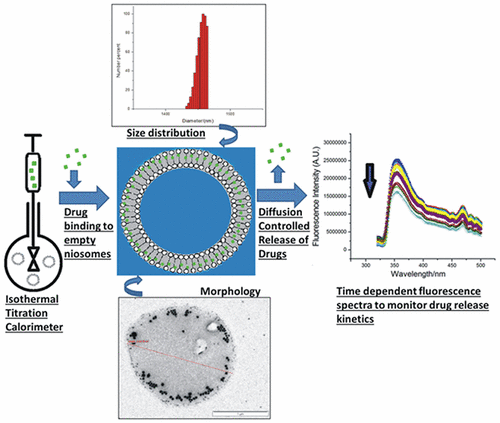当前位置:
X-MOL 学术
›
J. Phys. Chem. B
›
论文详情
Our official English website, www.x-mol.net, welcomes your
feedback! (Note: you will need to create a separate account there.)
Establishing Structure Property Relationship in Drug Partitioning into and Release from Niosomes: Physical Chemistry Insights with Anti-Inflammatory Drugs
The Journal of Physical Chemistry B ( IF 2.8 ) Pub Date : 2017-09-14 00:00:00 , DOI: 10.1021/acs.jpcb.7b06141 Moumita Dasgupta 1 , Nand Kishore 1
The Journal of Physical Chemistry B ( IF 2.8 ) Pub Date : 2017-09-14 00:00:00 , DOI: 10.1021/acs.jpcb.7b06141 Moumita Dasgupta 1 , Nand Kishore 1
Affiliation

|
Understanding the physical chemistry underlying interactions of drugs with delivery formulations is extremely important in devising effective drug delivery systems. The partitioning and release kinetics of diclofenac sodium and naproxen from Brij 30 and Triton X-100 niosomal formulations have been addressed based on structural characterization, partitioning energetics, and release kinetics, thus establishing a relationship between structures and observed properties. Both the drugs partition in nonpolar regions of TX-100 niosomes via stacking of aromatic rings. The combined effects of interactions of the drugs with polar head groups and the rigidity of the niosome vesicles determine entry and partitioning of drugs into niosomes. The observed slower rate of release of the drugs from the drug encapsulated niosomes of TX-100 than those of Brij 30, suggest stable complexation of drugs in the nonpolar interior of the former. No release of drugs from the niosomes was observed until 24 h even upon varying pH conditions without SDS. However, SDS in drug loaded niosomes led to release of drugs in as early as 6 h. The sustained pattern of in vitro release kinetics of the drugs thus observed from our niosomal preparations suggest these vesicular systems to be promising for pharamaceutical applications as potential drug delivery vehicles.
中文翻译:

建立药物分配入脂质体和从脂质体中释放出来的结构性质关系:抗炎药物的物理化学见解
在设计有效的药物递送系统时,了解药物与递送制剂相互作用的基础物理化学非常重要。基于结构表征,分配能学和释放动力学,已经研究了来自Brij 30和Triton X-100染色体制剂的双氯芬酸钠和萘普生的分配和释放动力学,从而建立了结构与观察到的性质之间的关系。两种药物都通过堆叠芳香环在TX-100脂质体的非极性区域中分配。药物与极性头部基团相互作用的相互作用和脂质体囊泡的刚度共同决定了药物进入脂质体的进入和分配。与Brij 30相比,观察到的TX-100包封的脂质体中药物的释放速度较慢,提示药物在前者的非极性内部稳定复合。直到24小时,即使在没有SDS的不同pH条件下,也未观察到药物从脂质体中释放出来。但是,载有药物的脂质体中的SDS最早可在6小时内导致药物释放。因此,从我们的血浆制剂中观察到的药物的体外释放动力学的持续模式表明,这些囊泡系统有望在药物学应用中作为潜在的药物递送载体。
更新日期:2017-09-15
中文翻译:

建立药物分配入脂质体和从脂质体中释放出来的结构性质关系:抗炎药物的物理化学见解
在设计有效的药物递送系统时,了解药物与递送制剂相互作用的基础物理化学非常重要。基于结构表征,分配能学和释放动力学,已经研究了来自Brij 30和Triton X-100染色体制剂的双氯芬酸钠和萘普生的分配和释放动力学,从而建立了结构与观察到的性质之间的关系。两种药物都通过堆叠芳香环在TX-100脂质体的非极性区域中分配。药物与极性头部基团相互作用的相互作用和脂质体囊泡的刚度共同决定了药物进入脂质体的进入和分配。与Brij 30相比,观察到的TX-100包封的脂质体中药物的释放速度较慢,提示药物在前者的非极性内部稳定复合。直到24小时,即使在没有SDS的不同pH条件下,也未观察到药物从脂质体中释放出来。但是,载有药物的脂质体中的SDS最早可在6小时内导致药物释放。因此,从我们的血浆制剂中观察到的药物的体外释放动力学的持续模式表明,这些囊泡系统有望在药物学应用中作为潜在的药物递送载体。











































 京公网安备 11010802027423号
京公网安备 11010802027423号